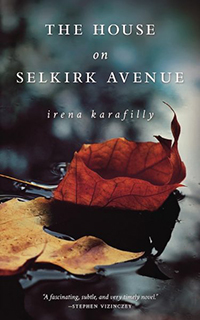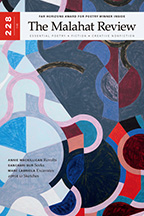Reviews
Fiction Review by Carol Matthews
Irena Karafilly, The House on Selkirk Avenue (Toronto Buffalo Lancaster: Guernica Editions, 2017. Paperbound. 299 pp, $20.00.
 Irena Karafilly, an award-winning Montreal writer and poet, has lived in five countries, and her writing reflects her cosmopolitan view of the world. One novel, Ashes and Miracles, was set in Poland; another, The Captive Sun, was set in Greece where it became a best-seller. In The House on Selkirk Avenue, the protagonist briefly recalls travels in France, Spain, Malaysia, Mexico, and England, yet the setting and flavour is unmistakably Montreal.
Irena Karafilly, an award-winning Montreal writer and poet, has lived in five countries, and her writing reflects her cosmopolitan view of the world. One novel, Ashes and Miracles, was set in Poland; another, The Captive Sun, was set in Greece where it became a best-seller. In The House on Selkirk Avenue, the protagonist briefly recalls travels in France, Spain, Malaysia, Mexico, and England, yet the setting and flavour is unmistakably Montreal.
The story begins with a flashback of twenty-three-year-old Kate’s train trip to Paris. Heartbroken over the break-up with Guillaume, her French-Canadian lover, she has a one-night stand with an unnamed French soldier, which results in pregnancy. Just before embarking on this trip she had received a proposal from a young medical intern, Brad Thuringer, and promised to give him an answer on her return. Fortunately, he is still prepared to marry her and raise her child as his own.
We track Kate’s reflections when, twenty-six years later, she is back in Montreal helping her daughter settle into an apartment and begin studies at McGill. Megan has discovered Guillaume’s farewell letter to Kate packed away in a cardboard box of books shipped to Montreal along with Megan’s possessions. The letter sets Kate on a nostalgic quest to revisit her old haunts and review the political circumstances that caused the separation in order to piece it together with the reality of the life she has lived since, in Alberta with her husband and children.
Having lived in Montreal during the sixties and returned there for frequent visits during the eighties and nineties, I found myself gripped by the novel’s portrayal of the time, place, and spirit of the city during those two periods. Karafilly accurately captures the initially comfortable oblivion of English Montrealers during the early days of the Quiet Revolution, the horror when James Cross is kidnapped and Pierre Laporte is murdered, followed by the shock and confusion when the War Measures Act is declared. The experience of many Montrealers is described vividly in Guillaume’s poignant account of being carted off and jailed in the Parthenais Detention Centre for twelve days and “living through a Kafkaesque nightmare.” At first believing that the authorities would realize “it was all a mistake,” he is finally released because of lack of evidence. Describing himself as “utterly changed” by the experience, he writes that he can’t see her or his family, and “can’t even play the cello!”
As Kate tramps around the city seeking glimpses of the past and spotting people who look like Guillaume, Karafilly offers evocative images of Montreal’s current street life: St. Denis Street, “with its fanciful gables and wrought-iron balconies trailing ivy and spider ferns, petunias and morning glories;” Chinatown, “with whiffs of roasting duck and Oriental spice, the sweetish odour of discarded fruit rotting in wooden crates” and Westmount Park grounds where winding paths, trees and duck ponds, “captivate at this time of year, flaming with gold and scarlet.”
“A photographer is never entirely off the job,” we are told, and Kate almost always has a camera slung on her shoulder as she snaps photos of park after park, person after person. The purpose of photography, its pleasures and its drawbacks, provide an important and intriguing reference throughout the novel. Karafilly has been described as having a painter’s eye but in fact, like Kate, it is through a photographer’s lens that she portrays her characters. At times, the persistent photographer’s eye becomes tedious, offering too much surface and not enough depth.
Brad, is described as tall, handsome, and up-and-coming, with “an impressive mop of brownish-red hair, the colour of a chestnut mare,” but it’s hard to sense him as full-blown individual. Ivan, who Kate meets in a bar and spends a night with in a hotel, is tall, sandy-haired, with twinkling eyes and a lopsided, oddly beguiling smile, but neither Kate nor the reader know more about him. The aging but still glamourous Antonia is perfumed and coiffed with “an eye-popping collection of jangling bracelets” but, despite her importance in the novel, she remains a caricature.
The “three R’s” of a typical memoir are remember, regret, and reflect. While Kate’s story has some of these elements, she does not seem to regret what seems a cavalier treatment of her devoted husband. Acknowledging that Brad has behaved with dignity and integrity toward her and all members of her family, she discounts him as complacent, overconfident, “a man who took exceptional pride in his own virtue.” She admits she’s been “aloof and unyielding” in resisting Brad’s attempts to win her over, but insists that “no one could accuse her of not trying hard enough.” At the end of the story, after Antonia’s dramatic and disastrous birthday party, Kate wants to call her husband, perhaps hoping he will rescue her once again. In the final pages, she becomes the subject of another photographer’s relentless attention, and the picture we see at that point is not a pretty one.
“Time flowing backward” is frequently mentioned observation in this novel which reminded me of Julian Barnes’ The Sense of an Ending and Nicole Krauss’s History of Love, in which older characters reflect on the fluidity of time and the malleability of memory. While lacking the subtle depths of Barnes and the brilliant complexities of Krauss, Karafilly has nonetheless produced a capably crafted and cleverly layered work that is revealed in careful stages like a set of nested bowls.
—Carol Matthews









